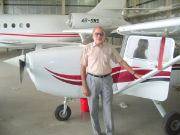
-----
Different grades of stainless steel
I am trying to establish the different components that go to make up the various grades of stainless steel.Can you please inform me of the various types of stainless steels as in, what's the difference between 18/10, 304, 306 etc. stc. I notice that some S/S is magnetic and some not, why? and how?
David JonesManufacturing - Melbourne, Australia
2005
Stainless Steels constitute a large family of iron-based engineering alloys containing a minimum of 12% Chromium. When you see 18/8, 18/10, 25/20 etc. the first is always Chromium and the second is always Nickel.There are several groups of stainlesses, known by their crystal packing or microstructural arrangement.These are: (generally)Austenitic - 300 series = 17 to 20+ Cr, 8 to 20+ Ni = non-magnetic.
Ferritic - usually less Cr and no Ni = magnetic.
Martensitic - 400 series = <18 Cr <5% Ni + Carbon for hardenabilty - magnetic.
Also duplexes and superduplexes = 25%Cr/20%Ni = non-mag, very corrosion resistant.
And also others - have mixed phases for special uses.Chromium provides oxide film on surface and hence corrosion resistance.Nickel provides strength mainly.Carbon is kept as low as possible (better corrosion resistance in welded structures) for all but the martensitics.Other elements added include Molybdenum for improved pitting resistance. And Nb, Ta, Ti, Cu, Se for various 'improvements'
(usually with some other penalty).Full magnetic behaviour is found only in the martensitics because that is the type most like 'ordinary' steels.The common austenitics are not normally magnetic because the various alloying additions alter the phase diagram to allow the non-magnetic austenite phase to exist at room temperature. 'Ordinary' steels are austenitic at high temperature, and are therefore non-magnetic when hot.Hope that's enough for you.Regards
- Plymouth, Devon, UK
2005
David, in addition to Martin's fine summary, you may find Publication #9014, "DESIGN GUIDELINES FOR THE SELECTION AND USE OF STAINLESS STEELS (1976)" of the Nickel Institute worthwhile. Go to http://www.nickelinstitute.org/index.cfm and download it.

Lee Gearhart
metallurgist - E. Aurora, New York
2005
2007
I have to bend a stainless steel sheet 0.6 mm thick size 30 mm x105 mm at 60 degrees angle . the bend line to be in the middle of 105 mm side i.e the 2 sides of the angle would be about 52.5 mm each.
the material is to be magnetic with slight springing quality. actually these are clips

abdul shukoor khan
- Hyderabad, andhra, India
May 14, 2009
⇦ Tip: Readers want to learn from your situation;
so some readers skip abstract questions.
Is there such a type of stainless that's graded 330?
JOSEPH RUSSO- WESTALLIS WISCONSIN
Q, A, or Comment on THIS thread -or- Start a NEW Thread
